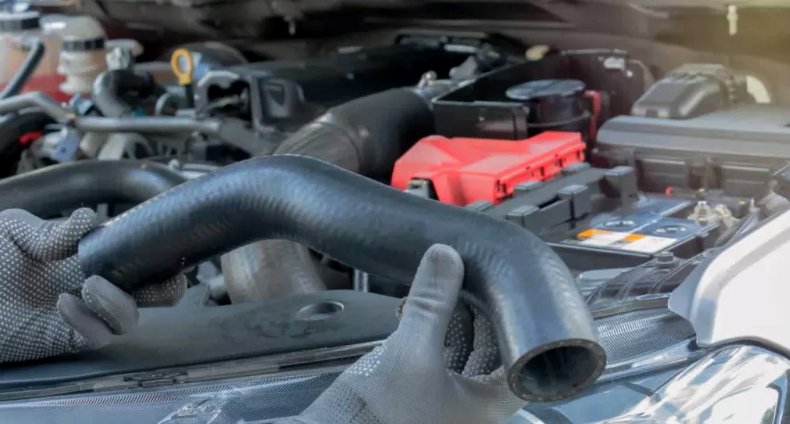사진을 찍으십시오: 당신은 고속도로를 순항하고 있습니다, 갑자기 당신 아래에 엔진이 퍼져 있습니다, 증기가 후드 아래에서 쏟아지기 시작합니다.. 이 악몽 시나리오는 삐걱 거리는 소리로 여행을 가져옵니다., 그러나 비용이 많이 들고 예방 가능한 문제를 알 수 있습니다. 도매 업체 및 자동차 제조업체의 경우, 원인과 이러한 문제를 예방하는 방법을 아는 것은 중요합니다.. 이 심층 가이드에서, 우리는 가장 일반적인 원인을 살펴볼 것입니다, 일찍 손상을 발견하는 방법, 차량을 원활하게 운영하기위한 최상의 예방 조치.
라디에이터 호스가 터지는 가장 일반적인 이유는 냉각 시스템의 압력이 너무 많기 때문입니다., 일반적으로 플러그 업 라디에이터 또는 불량 라디에이터 캡과 같은 막힘에서. 높은 엔진 부하와 고속의 시간 동안 호스에 추가 스트레스를 줄 수 있습니다., 그들이 설계된 것 이상으로 뻗어.
그러나 그것은 빙산의 일각 일뿐입니다. 다이빙합시다.
라디에이터 호스가 터지는 원인?
- 1. 너무 많은 압력: 냉각 시스템이 너무 많은 압력을 가할 때, 일반적으로 막힌 라디에이터 또는 불량 라디에이터 캡으로 인해, 호스가 터질 수 있습니다. 이것은 차량이 무거운 짐을 싣거나 고속으로 이동할 때 종종 발생합니다..
- 2. 정상적인 마모: 라디에이터 호스는 냉각 시스템 내부의 가혹한 환경에 살고 있습니다.. 시간이 지남에 따라, 뜨거운 냉각수 및 엔진 진동에 노출되면 호스가 분해 될 수 있습니다., 꺾이다, 그리고 결국 실패.
- 3. 부적절한 설치: 호스를 올바르게 설치하지 않으면, 그들은 너무 많은 스트레스 나 움직임을받을 수 있습니다, 그들이 마모되거나 부러지게합니다. 여기에는 너무 빡빡한 호스가 포함됩니다, 너무 느슨합니다, 또는 설치 중에 꼬인.
- 4. 화학적 고장: 라디에이터 호스의 냉각수에는 제조업체의 권장 사항에 따라 냉각수를 변경하지 않으면 시간이 지남에 따라 호스 재료를 분해 할 수있는 화학 물질이 포함되어 있습니다..
- 5. 온도 변화: 온도가 변함에 따라 호스가 확장되고 수축됩니다. 시간이 지남에 따라, 이것은 구조를 약화시키고 호스가 깨지고 터지게합니다..
- 6. 물리적 손상: 도로 파편과 같은 외부 소스의 손상, 호스에 대해 문지르는 엔진 부품, 또는 부적절한 유지 보수 관행은 압력을받는 약점을 만들 수 있습니다..
라디에이터 호스가 손상되었는지 여부를 결정하는 방법?
- 1. 물리적 점검: 균열을 찾아보세요, 부푼 것, 또는 호스 표면에 분할.
- 2. 누출: 호스 연결 근처에서 냉각수 누출은 문제의 징후 일 수 있습니다..
- 3. 부드러운 반점: 호스의 비정상적으로 부드러운 부위를 느끼면 내부 손상이 나타날 수 있습니다..
라디에이터 호스 유지 보수를위한 예방 조치
- 1. 정기적으로 호스를 점검하십시오: 라디에이터 호스의 마모를 확인하십시오, 누출, 또는 정기적으로 손상. 석유를 교체 할 때 또는 다른 일상적인 유지 보수 중에 호스를 확인하는 것이 좋습니다..
- 2. 올바른 냉각수를 사용하십시오: 올바른 냉각수를 사용하여 제조업체의 권장 사항에 따라 혼합하십시오.. 잘못된 냉각수는 호스 분해 속도를 높일 수 있습니다.
- 3. 연결이 빡빡했는지 확인하십시오: 누출과 미끄러짐을 방지하기 위해 모든 호스 클램프와 연결이 빡빡하고 안전한 지 확인하십시오., 그러나 그들을 과도하게 밟지 마십시오. 과도하게 조롱하면 호스가 약해져 실패 할 수 있습니다.
- 4. 오염 물질을 멀리하십시오: 오일을 방지하기 위해 엔진 실을 깨끗하게 유지하십시오, 유지, 그리고 당신의 호스와 접촉하는 다른 오염 물질. 그들은 시간이 지남에 따라 고무를 분해 할 수 있습니다.
- 5. 온도 게이지를 시청하십시오: 엔진의 온도 게이지를 주시하여 냉각 시스템이 일반 범위 내에서 작동하고 있는지 확인하십시오.. 과열은 실패한 호스 또는 기타 냉각 시스템 문제의 징후 일 수 있습니다..
- 6. 냉각수 시스템을 플러시하십시오: 냉각수 시스템을 정기적으로 플러시하고 이전 냉각수를 교체하여 호스 및 기타 냉각 시스템 구성 요소를 손상시킬 수있는 잔해 및 부식성 물질을 제거하십시오..
- 7. 물리적 손상으로부터 보호하십시오: 라디에이터 호스가 잠재적 인 물리적 손상으로부터 보호되는지 확인하십시오., 날카로운 모서리를 문지르거나 엔진 실의 움직이는 부품.
- 8. 일정에 따라 교체하십시오: 라디에이터 호스를 교체하려면 예방 유지 보수 일정을 따르십시오, 그들이 마모의 눈에 띄는 징후를 보이지 않더라도. 제조업체의 권장 사항 또는 첫 번째 마모 표시에 따라 호스를 교체하십시오., 일반적으로 모든 4 에게 5 연령.
- 9. 품질 부품을 사용하십시오: 호스를 교체 할 때, 고품질을 사용하십시오, OEM과 동등하거나 더 나은 호스. 그들은 더 오래 지속되는 경향이 있으며 호스 고장의 일반적인 원인에 저항합니다..
- 10. 전문 검사를 받으십시오: 호스 상태에 대해 잘 모르거나 냉각 시스템 문제의 증상이 발견되는 경우, 전문적인 기계공이 더 심각한 문제를 예방하도록 검사하십시오..
라디에이터 호스 파열의 문제를 해결하는 방법?
- 1. 즉각적인 조치: 운전하는 동안 호스가 터지는 경우, 안전하게 끌어 당겨 엔진을 차단하여 추가 손상을 방지하십시오..
- 2. 검사 및 교체: 기계공이 시스템을 검사하고 즉시 손상된 호스를 교체하십시오..
- 3. 시스템 점검: 미래의 호스 버스트를 방지하기 위해 전체 냉각 시스템을 확인했는지 확인하십시오..
라디에이터 호스를 유지하는 방법을 아는 것은 문제를 예방하는 데 도움이 될뿐만 아니라, 그러나 그것은 또한 당신의 차량의 수명을 연장 할 것입니다. 정기적으로 확인하고 무엇을 찾아야하는지 알고, 파열하려는 호스를 잡고 차량을 계속 달리고 안전하게.
요약
라이드를 신뢰할 수 있도록, 라디에이터를 오가는 냉각수를 운반하는 호스를 돌봐야합니다.. 그것은 마모와 손상의 징후를 지켜 보는 것을 의미합니다, 올바르게 설치되었는지 확인하십시오, 그리고 시스템을 정기적으로 확인합니다. 당신이 적극적이라면, 호스 버스트와 함께 제공되는 예상치 못한 수리 및 다운 타임을 피할 수 있습니다..





